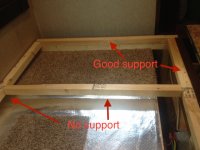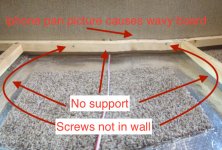Over a year ago I bought a new king mattress for our Landmark because the original mattress was so horrible. On the old mattress my wife and I would end up in the huge sag at the middle of the bed. Sore backs and hips were the norm. The new mattress is much butter but I still think my wife and I gravitate to each other in the middle of the bed (insert your own jokes here).
Well yesterday one of the cable covers (board with carpeting on it) fell off and blocked/kept the bedroom slide from going out. To reinstall it I had to take off the mattress and the plywood covering the bed frame. What I discovered is there is almost zero support (other than the plywood) for the middle of the mattress at the head of the bed. I've added some pictures showing the problem.
After looking at the pictures I'm wondering why Heartland used just two screws (mine aren't even in the wall and allow the 2x2 to sag) to try to hold the head frame support to the wall instead of just putting blocks underneath? Any ideas? I imagine this causes quite a few back problems and sleepless nights for many folks. I'd like to add some blocks but don't want to if there is a good engineering reason (other than weight reduction) behind the screws.
Well yesterday one of the cable covers (board with carpeting on it) fell off and blocked/kept the bedroom slide from going out. To reinstall it I had to take off the mattress and the plywood covering the bed frame. What I discovered is there is almost zero support (other than the plywood) for the middle of the mattress at the head of the bed. I've added some pictures showing the problem.
After looking at the pictures I'm wondering why Heartland used just two screws (mine aren't even in the wall and allow the 2x2 to sag) to try to hold the head frame support to the wall instead of just putting blocks underneath? Any ideas? I imagine this causes quite a few back problems and sleepless nights for many folks. I'd like to add some blocks but don't want to if there is a good engineering reason (other than weight reduction) behind the screws.



